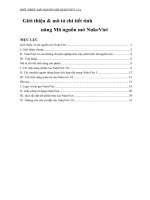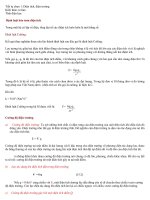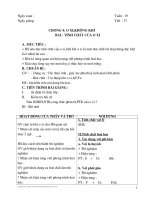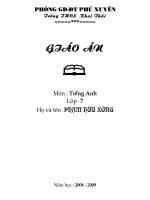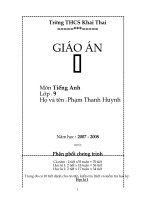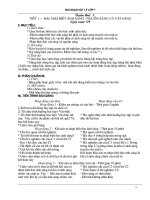GA TA 11 chi tiet
Bạn đang xem bản rút gọn của tài liệu. Xem và tải ngay bản đầy đủ của tài liệu tại đây (417.96 KB, 38 trang )
Mai Vaên Nhaân
Week 1 - period 1 – Date : August 10
th
2008
INTRODUCTION
A.OBJECTIVES:
By the end of the lesson, students will:
- Know how to learn English 11
- Do the test well
B. TEACHING AIDS: textbook, pictures, cassette, tape
C. PROCEDURE:
Method: mainly communicative
Teacher’s activities Students’ activities
* Introduction
-introduce the content of the book including six topics :
1.You and me
2.Education
3.Community
4.Recreation
5.Nature and Environment
6.People and places
-> six topics are divided into sixteen units
-The design of each unit in textbook:
1.Unit: express the theme
2.Reading:developing reading skill
3.Speaking:developing speaking skill
4.Listening:developing listenning skill
5.Writing:developing writing skill
6.Language focus:learning grammar and pronounciation
-After 3 unit , you have one period for test yourself.It helps
you test yourself about what you’ve learnt.
-Test:
1-check frequence knowledge for the previous lesson.
2-Fifteen minutes test (3 times)
3-One period test (2 times )
4-Semester test (Once for each semester)
-The new point in learning E 11
-Communicative method /approach
-Task - based method /teaching
-The book is designed with 4 skills
-Commplete and various tests
- Learner - centered approach
-Results:
-T asks Ss to work in pairs and make acquainted with a
friend by using suggested questions:
1.What’s your name? 2.How old are you?
3.Where do you live? 4.Where do you study?
5.What subjects do you study at school?
6.What’s your favourite subject?Why do you like it?
7.What do you often do in your free-time?
8.What do you want to be in the future?
-Students listen to T’s explanation
about six topics
-Listen and take notes in their
notebooks.
-Listen and take notes in their
notebooks.
Work in pair and make a small
conversation with a friend.
-Homework:
- Prepare Unit1, Reading.
UNIT 1 : FRIENDSHIP
- 1 -
Mai Vaên Nhaân
PERIOD 2 : A. READING
I. AIMS OF THE LESSON:
1. Language skills:
• Reading : By the end of the lesson, Students will be able to :
- Develop such reading micro-skills as scanning for specific ideas, skimming for
general information, and guessing meaning in context.
- Use the information they have read to discuss the topic.
- Read and try to guess the meanings of words and expressions
- Passage comprehension.
- Finding the main content of the lesson.
2. Language focus :
Vocabulary: mutual, incapable of, unselfish, acquaintance, give-and take, loyal to,
suspicious,…
• Grammar :
- The simple present.
- Mutual pronoun “each other”.
II. TEACHING AIDS: Cassette player, tape, chalks, pictures, handouts, charts, real objects if
possible
III. TEACHING METHOD: Communicative approach
IV. PROCEDURE:
Teacher’s Activities Students’ Activities
WARM-UP ( 4’)
Competition game-Network
T prepares a hanhout with a network of the
word “Friend”
PRE-READING (3’)
Stick the picture in the textbook on the board
Ask some questions:
- What are the people in the picture doing?
- What is the boy doing? - Are they happy?
- In your opinion, what relationship are they?
- Play the cassette
- Ask students to pay attention to the intonation
- Teacher goes around for helps.
Pre-teaching Vocabulary
-Lasting(a): lifelong
-Constant(a): happening all the time
constancy(n)
-Loyalty (n)
-Trust (v) , (n): the belief that is honest.
-Suspicion (n)
-Rumour (n) piece of information that people
talk about.
-Gossip (n) informal talk that may be unkind or
not true.
-Sympathy (n)
Students work in groups
Work in pairs
-Listen once or twice
-Discuss the answers to the questions.
-Model the discussion in front of the class.
WHILE- READING (26’)
- 2 -
Friend
Mai Vaên Nhaân
- Introduce three tasks.
-Have students read the whole passage (once or
twice) and do the tasks.
* TASK 1:
-Guide students how to do this task.
- Teacher goes around for any help.
-Compare the results of the others and correct
mistakes.
* TASK 2:
-Ask students to read the four sentences in the
textbook and choose the best answer
- Compare the result and correct mistakes.
* TASK 3:
-Have students discuss questions.
-Observe class and help students.
- Teacher goes around for any helps.
- Correct mistakes.
-Read silently individually
- Choose the correct word in the box to complete
each sentence.
- Keys:
1. mutual 2. incapable of
3. unselfish 4. acquaintance/ friend
5. give-and-take 6. loyal to
7. suspicious
Work in pairs
-Key: B
Work in pairs
-Suggested keys:
1. The first quality for true friendship is
unselfishness. It tells me / us that a person who is
concerned only with his own interests and
feelings cannot be a true friend.
2. Changeable and uncertain people are
incapable of true friendship because they take up
an interest with enthusiasm, they are soon tired of
it, and they feel the attraction of some new
object.
3. The third quality for true friendship is loyalty. It
tells us that two friends must be loyal to each
other, and they must know each other so well that
there can be no suspicions between them.
4. There must be mutual trust between friends
because if not, people cannot feel safe when
telling the other their most intimate secrets.
5. Talkative people can’t keep a friend long
because they can’t keep a secret, either of their
own or others.
6. The last quality for true friendship is sympathy.
It tells us that to be a true friend, you must
sympathize with your friend. Where there’s no
mutual sympathy between friends, there’s no true
friendship.
POST READING (10’)
- Teacher asks a general question, “Why do we
need true friendship?”
Students give their opinions
Discussion (group-work)
V. HOMEWORK: (2’)
- Study new words.
- Do the tasks in the notebooks.
- Prepare Speaking.
UNIT 1 : FRIENDSHIP
PERIOD 3 : B. SPEAKING
- 3 -
Mai Vaên Nhaân
I. AIMS OF THE LESSON:
1. Language skills :
• Speaking: - Describing physical characteristics
- Discussing personalities
- Role-play: Talking about a famous friend
2. Language focus:
Vocabulary: a handout of the adjectives and expressions.
II. TEACHING AIDS: Chalks, pictures, handouts, charts, real objects if possible
III. TEACHING METHOD: Communicative approach
IV. PROCEDURE:
Teacher’s Activities Students’ Activities
WARM-UP (2’)
- Give Sts some pictures, then ask them to
describe the people in these pictures
- Ask some questions:
1/Do you concern about your outlook?
2/ Is it important to you?
PRE-SPEAKING (4’)
- Lead sts to the main content
- Present some new words
* characteristic (n)
* personality (n)
* forehead (n)
* crooked (a)
* hospitable (a)
- Sts may speak in Vietnamese
- Students work in groups and describe
- Answer individually:
* Yes, I do…
* Yes, it is…
- Listen carefully
- Take notes
WHILE- SPEAKING (29’)
Task 1
- Ask sts to look at the pictures (page 15) and
answer questions :
1. How many people are there in the picture?
2. Can you guess how old they are?
- Explain the useful language (page 16):
* height : tall , medium , short …
* face : square , large , oval …
* forehead : broad , high …
* nose : straight , crooked …
* hair : black , grey …
* appearance : handsome , beautiful , good-
looking …
- “ Now let‘s start with the physical description
of each person , using the guided
+ question: Can you describe the _____ in the
picture? “
+ answer: The ____ is height. He / she has____
face, and a _____ nose. His / her hair is _____.
His / her appearance is ______.
- Look and answer questions in pairs:
1. There are 4.
2. - The boy is 18.
- The girl is 16.
- The man is 42.
- The woman is 28
- Listen and take notes.
- Work in pairs
+ The boy is short. He has a large face , …
+ The girl is ………
- Play roles.
- 4 -
Mai Vaên Nhaân
- Help sts with some new words.
- Ask sts to make questions and answer
questions with a partner, using the information
from the picture.
- Ask sts to perform.
- Correct sts’mistakes and pronunciation.
Task 2
- Divide class into four groups.
- Explain some words of personalities on page
16.
- Guide them to discuss and decide which
personalities are important to a person and in
friendship.
- Let sts number the following personalities in
order of importance in friendship.
caring , hospitable , modest , sincere ,
generous , honest , helpful , understanding ,
pleasant
- Pay attention that there’re no answer keys for
this task.
- Present their performance.
- Work in groups of four.
- List some personalities of a person.
- State some reasons why they choose.
- Discuss and say the reasons.
- Report their results to the class and explain why
they do like that …
POST –SPEAKING (10’)
- Have sts work in pairs.
- Guide them to do the task.
- Make sure that sts understand their roles
- Pay attention to the suggestions :
+ his / her name
+ date of birth
+ his / her physical characteristics
+ his / her hobbies
+ his / her personalities ( friendly , humorous ,
quick-witted , good-natured , helpful , honest ,
pleasant , caring )
+ why he / she interests in Maths
+ how much time he / she spends on Maths
everyday
+ what makes him / her a good friend
+ what made him / her successful ( studious ,
intelligent , keenly interested in Maths, eager
to learn , patient , calm )
+ what he / she does in his / her free time
- Call some pairs to report.
- Work in pairs
- Make pairs: one is a journalist, the other is an
interviewee.
- Listen carefully.
- Practise in pairs.
- Pay attention to the content :
+ physical characteristics
+ personalities
+ reasons why the friends are famous
- Role play
- Perform their task.
V. HOMEWORK:
- Learn by heart some new words.
- Prepare part C: Listening
Handout: UNIT ONE – SPEAKING (Grade 11)
I. Useful vocabulary
- 5 -
Mai Vaên Nhaân
1: Height (chiều cao): medium height (cao trung bình), rather short (hơi thấp), too tall (rất cao) …
2. Face (khuôn mặt): round, square, diamond, oblong, triangular, oval, heart …
1
2
3 4
5
6
7
3. Hair (kiểu tóc) wavy, curly, straight, bald, short, long …
1
2
3
4
4. Forehead (trán): high (cao), low (thấp) …
5. Nose (mũi): long, short, straight (thẳng), flat (tẹt), turned-up (hếch), crooked (khoằm) …
6. Eyes (mắt): green, blue, brown, gray …
7. Appearance (diện mạo): plain (ngay thẳng, chất phát), attractive (cuốn hút), well-dressed (ăn mặc đẹp)
casually-dressed (mặc quần áo bình thường), handsome (đẹp trai), beautiful
(đẹp), good-looking (dễ nhìn), pretty (xinh xắn), moustache (ria), beard (râu ở
cằm và hai bên má) …
8. Mouth (miệng): heart-shaped (hình trái tim), wide (rộng), thin/ thick lips (môi mỏng/dày) …
9. Build (tướng mạo): thin (ốm), slender (mảnh mai), muscular (vạm vỡ), plump (béo), heavy built
(đô, lực lưỡng), overweight (béo phì), fat (béo, mũm mĩm)
10. Age (tuổi tác) young (trẻ), middle-aged (ở tuổi trung niên), elderly (lớn tuổi, cao tuổi), old
(già), in his early/mid/late fifties …
11. Characters (tính cách): easygoing (dễ chịu), friendly (thân thiện), hardworking (làm việc siêng năng),
honest (thật thà), intelligent (thông minh), kind (tử tế, tốt bụng), mature (trưởng
thành), patient (kiên nhẫn), polite (lịch sự), sincere (chân thành), sympathetic
(thông cảm), tolerant (biết tha thứ), trustworthy (đáng tin cậy), learned man
(người hiểu biết), caring (chu đáo), helpful (hay giúp đỡ), pleasant (dễ chịu),
modest (khiêm tốn), generous (rộng lượng), hospitable (mến khách, hiếu khách)
II. Useful expression:
1. He is in his early / mid / late forties.
2. He has got a square face with …
3. He is rather short … / he is of medium height …
4. She wears her hair long / in a bun / in a ponytail …
UNIT 1 : FRIENDSHIP
PERIOD 4 : C. LISTENING
I. AIMS OF THE LESSON:
1. Language skills :
- 6 -
Mai Văn Nhân
• Listening : - Develop such listening micro-skills as intensive listening for specific
information and taking notes while listening.
2. Language focus :
Vocabulary: apartment building,sense of humour, give sb a ring, go through a
rough time.
II. TEACHING AIDS: Cassette player, tape, chalks, pictures, handouts.
III. TEACHING METHOD: Communicative approach
IV. PROCEDURE:
Teacher’s Activities Students’ Activities
WARM-UP ( 5’)
Guessing game
T introduces the game: one student goes to the
boarb and T gives him / her a piece of paper with
the name of a student in the class. Other Ss have
to ask Yes / No questions to find out who the
student is. Ss should ask about the appearance,
personalities, or clothes.
PRE-LISTENING ( 6’)
-Ask students some more questions:
• How do you meet your best friend?
• How long have you known your best
friend (him or her)?
Vocabulary Pre-teaching
-Explain some new words & phrases:
-Apartment building: toà nhà có nhiều căn hộ
-Sense of humour: khiếu hài hước
-Give sb a ring: phone sb
- Go through a rough time: trải qua thời kỳ khó
khăn
Ss may ask questions such as:
+ Is the person a girl?
+ Is she tall?
+ Is she short-sighted?
+ Is she friendly?
-The pointed students answer
-Students repeat & take notes
WHILE- LISTENING ( 26’)
Task 1
-Have students read the true-false statement list
and questions in textbook silently for several
minutes to make sure that every student
understands them.
Play the tape once for Ss to do the task.
Ask Ss to work in groups of 4 to compare their
answers.
Give the correct answers.
Task 2
Play the tape again for Ss to complete their notes.
After playing the tape, T gets Ss to work in pairs
and check their answers.
Provide correct answers if necessary.
-Students read task1 silently for gist
-Elicited students raise their hands to interpret.
Suggested answers:
1. F
2. F
3. T
4. F
5. T
6. F
-Students take notes during listening.
-Other students watch and give comments.
- 7 -
Mai Vaên Nhaân
POST LISTENING ( 6’)
Get Ss to work in pairs to talk about how Ha has
been Lan’s best friend and how Minh has been
Long’s best friend.
T goes around to offer help and collect Ss’
mistakes
T calls on some pairs to present their answers.
T elicits feedback from the class and give final
comments
Whole class & pair work
V. WRAPPING UP ( 2’)
-T summarizes the main points of the lesson.
-T asks Ss to learn by heart all new words and
do the extra exercise as homework.
-T asks Ss to prepare Writing.
Key content: ( Task 2)
Where & how they met What they like about their friends
Lan -They used to live in the same residential
area in Ha Noi.
-Lan went on a holiday to Do Son & Ha went
there to visit her.
-Ha is very friendly & helpful.
-Ha is sociable. She’s got many friends in Do
Son & she introduced Lan around.
Long -They met in the college.
-Minh played the guitar, Long was a singer.
-They worked together.
-Minh has a sense of humour.
-Minh likes to go to plays & movies.
-Minh is a good listener.
-Minh is friendly & helpful
UNIT 1 : FRIENDSHIP
PERIOD 5 : D. WRITING
I. AIMS OF THE LESSON:
1. Language skills:
• Writing: - Write about a friend, real or imaginary, using the words and expressions that
they have learn in previous lessons
2. Language focus:
Vocabulary: Revise the adjectives and expressions Ss can use to describe their
friend’s appearance and personalities.
II. TEACHING AIDS: textbook, handouts.
III. TEACHING METHOD: communicative approach
IV. PROCEDURE:
Teacher’s Activities Students’ Activities
WARM-UP ( 5’)
Competition game
T divides the class into small groups of 3- 4
students.
Ask Ss to write down the adjectives that describe
the appearance and personalities.
PRE-WRITING ( 8’)
- Teacher asks students to think about a friend they
like.
-Teacher raises a few guiding questions.
1. What is your friend name?
2. How old is he / she?
Personalities: caring, hospitable,
modest, sincere, generous, honest,
helpful, understanding, pleasant,
friendly, humouruos, quick-witted, good-
natured, studious, patient, calm
Appearance: tall, short, thin, fat, good-
looking, beautiful, handsome, slim…
Students ‘answers
1. My friend’s name is Hoa
2. She is 17 years old.
- 8 -
Mai Vaên Nhaân
3. Where and when did you meet each other?
-Teacher uses a picture to gives some key words
to describe someone’s physical characteristics
( height , hair , eyes , face , clothes…) and his /
her personalities
(helpful, sincere…) and some necessary structures.
3. We met each other at my cousin’s birthday
party 4 years ago.
WHILE-WRITING ( 20’)
-Teacher gives a sample and has students write a
passage to describe a friend they like.
A Sample
Hoa has been my best friend since many years.
She is quite a lively person. She is fairly tall with
a good finger. She’s got a heart- shaped face with
a small sort of turned- up nose. It is very
attractive. She has got long, black wavy hair and
blue eyes with very long eyelashes. Her
complexion is white. Her lips are very full and
she has got dimples in her checks. Now she lives
very far from me, but we still keep contact
through e- mail.
Students write a passage.
POST WRITING (10’)
-Teacher asks students to read / write some
students’passsages on the board and Teacher gives
comments.
-Students read / write some students’passsages
on the board.
V. WRAPPING UP (2’)
-Ask Ss to improve their writing, taking into consideration their friends’ and T’s suggestions and
correction and do the extra exercise.
-Prepare Language Focus.
UNIT 1 : FRIENDSHIP
PERIOD 6 : E. LANGUAGE FOCUS
I.AIMS OF THE LESSON:
- Distinguish the sounds / d
Ʒ
/ and / t∫ /.
- Pronounce the words and sentences containing these sounds correctly.
- Use some structures containing infinitives with and without to appropriately.
II. TEACHING AIDS: textbook, handouts.
III. TEACHING METHOD: communicative approach
IV. PROCEDURE:
Teacher’s Activities Students’ Activities
PRONUNCIATION (12’)
- Read / d
Ʒ
/ and / t∫ / and distinguish them.
- Get students to read / d
Ʒ
/ and / t∫ / twice.
- Read the words in the part “Listen and repeat”
clearly for students to repeat.
- Require some students to read these words and
correct mistakes
- Listen and try to find out the difference in
pronouncing / d
Ʒ
/ and / t∫ /
- Read the two vowels.
- Repeat the words.
- Pronounce the words.
- 9 -
Mai Vaên Nhaân
- Read the sentences in the part “Practise reading
these sentences” as a model.
- Let students repeat after the teacher.
- Get students to practise reading these sentences
while teacher goes around to give help.
- Call some sts to read them aloud.
- Listen and try to remember the way to read
the sentences.
- Repeat
- Practise reading sentences
GRAMMAR (10’)
Set 4 examples and ask sts to supply the correct
verb forms in brackets.
1. She is studying English (go) to the USA.
2. It is useful (know) how to drive.
3. The film makes her (cry).
4. I heard them (talk) in the next room.
T corrects and asks sts when they use To
infinitive and infinitive without To.
Give the presentation of the language point:
1. Infinitive with To :
+ To indicate the purpose or intention of an
action.
+ To begin the sentence with “IT”
+ As an object of a verb.
+ … too … to / … enough to -inf.
Ask sts to do exercise 1 in textbooks.
Put the words in the correct order to make
sentences, writing the main verb in the present
simple and making the other an infinitive with to.
Call some sts to write the answers on the board.
T corrects.
Give feedback.
2. Infinitive without To:
-Based on example 3, 4 at the beginning.
-Give the presentation of the language point:
+ We use bare infinitive after verbs make, let
Let / make + object + infinitive without TO.
+ After some perceptive verbs such as: see, hear,
smell, feel, watch, observe …
-Ask sts to do exercise 2 /P21.
-Rewrite the sentences, using the words given in
brackets.
-Call some sts to write the answers on the board.
Check with the class.
• HOMEWORK:
* Make questions for the responses:
1). I saw him sit in the park alone.
2). Nothing. I think we have to eat out today.
3). Too tired to go now.
Give the correct verb forms (individually)
1. to go
2. to know
3. cry
4. talk
Pairs work
Answer key:
1.Who wants something to eat
2.I have some letters to write
3.I am delighted to hear the news
4.My mother has some shopping to do.
5.You always have too much to talk about.
6.It’s lovely to see you again.
7.It is was too cold to go out.
Pairs work
Answer key:
1. The police watched them get out of
the car.
2. They let him write a letter to his wife.
3. I heard them talk in the next room.
4. The custom officer made him open the
briefcase.
5. The boy saw the cat jump through the
window.
6. Do you think the company will make
him pay some extra money ?
- 10 -
Mai Vaên Nhaân
4). Why not? Let’s join them.
5). Oh, he‘s old enough.
- Learn the new words.
- Do the exercises again in their notebooks
- Prepare for the unit 2
7. I felt the animal move toward me.
8. Do you think her parents will let him
go for a picnic?
UNIT 2: PERSONAL EXPERIENCES
PERIOD 7 : READING
I. AIMS OF THE LESSON:
- Develop such reading micro-skill as scanning for specific ideas, identifying the sequence of
events and guessing meaning in context.
-Use the information they have read to discuss the story.
II. TEACHING AIDS: Cassette player, tape, chalks, pictures, handouts, charts, real objects if
possible
III. TEACHING METHOD: communicative approach
IV. PROCEDURE:
- 11 -
Mai Văn Nhân
- 12 -
Time Teacher’s activities Students’ activities
5’
7’
5’
8’’
I.Warm up
-Ask Ss to find suitable words to fill in the chart
below:
Keys: sad , happy, excited , bored , frightened,
upset, confused, etc..
II.Before you read
- Ask pupils to work in pair, describe each picture
and then guess what is happening it
- Call some students to stand up and describe each
picture
-Ask some question to lead in the reading:
a).If you got bad marks, how would you feel?
b). If you made a mistake, how would you
feel?
Transition: - In today’s reading, we’ll get to know
about the things that have happened to you that
influence the way you think and behave. It is
“Personal experiences”.
- provide pupils with words and structures
appearing in the text
- embrace / imbreis / (v) ôm ấp
- embarrassing (adj)
ex: It was an embarrassing story
-idol (n) = someone greatly loved or admired
- floppy (a): mềm
- floppy disk: đóa mềm
- glance at /glans / (v) : liếc nhanh
- make a fuss : làm ầm ó lên
- At once = immediately
- look great = linking verb + adj(õ tuyệt vời)
- sneaky /sniki / (adj) : vụng trộm
- Guide pupils to read the words twice in chorus
III. While you read
1.Task 1
- ask students to read the text twice individually,
and then in pairs work out the answers for Task 1.
- Call one to write answers on board and the rest
do orally.
-Correct and explain if necessary
2.Task 2: Pupils read the text again and put the
pictures in correct order
-ask Ss read the text again and sequence the
events
Look at the chart
Discuss and find out the words
Fill in the blanks
- Look at the pictures and guess
Ex: In (d), a little girl is watching TV.
On the screen, she sees a young girl
wearing a beautiful hat
- Tell the class what they see in each
picture
- take notes
- read aloud after the teacher
-take notes
-Do as guided
-Write down the correct answer
Key: 1. glanced 2. making a fuss
3. embarrassing 4. idols
5. sneaky
Read out their sentences, others give
remarks
Suggested answers
Feeling
sggs
Mai Vaên Nhaân
UNIT 2: PERSONAL EXPERIENCES
PERIOD 8 : SPEAKING
I. AIMS OF THE LESSON:
1. Language skills:
• Speaking:
Identify structures that are used to talk about past experiences and their
influences on one’s life.
2. Language focus :
Grammars: - present perfect and past simple
- structure with “make”
II. TEACHING AIDS: textbook, pictures, handouts.
III. TEACHING METHOD: communicative approach
IV. PROCEDURE:
Time Teacher’s activities Students’ activities
5’
5’
10’
15’
I.Warm up
- Have you ever spoken English to you friends
( teachers, foreigners…) ?
- How did you feel when you spoke English to
them?
II. Pre-Speaking
- Give students some new words
1. Confidence
2. Attitude
3. Native English speaker
4. Appreciate
1.Task 1: language input
Matching phrases:
- Ask students to do Task 1 in pairs
-go round and provide help if necessary
-call on some Ss to read their answers
-check correct answers
II. While speaking
2.Task 2: Ordering the dialogue:
-Introduce task 2 (p.25).
-Ask Ss to open their books and do the task.
-Explain voc. :
▪turtle (n) : (real object)
-Go around helping Sts.
-Ask them to give answers
-Call some pairs to practice the dialogue without
using books
-give feedback
3.Task 3: Dialogue building
-Ask pupils to underline the structures using to talk
about past experiences
-Use these structures and ideas in Task 1 to make
- Give answers
Take notes
Pairs work
-Say aloud their result.
*Suggested answers: 1d 2c 3a 4b
5e
-Listen.
-Read.
-Take notes.
-Work in pairs to put the correct order.
Correct: 1b, 2d, 3h, 4a, 5e, 6g, 7c, 8f
In pairs, practice the dialogue
-Underline the structures:
+Have you ever …?
+How did it happen?
+When did it happen?
+How did the experience affect you
-Work in pairs to make dialogue
- 13 -
Mai Vaên Nhaân
8’
2’
similar dialogues
-Go around helping.
*Note: Use Simple Past and Past Perfect to talk
about past experiences.
* Suggested dialogues :
1. A. Have you ever feeled an exam?
- Yes, I have.
B. How did it happen?
- I didn’t study well enough for exam.
C. When did it happen?
- Last year.
D. How did you feel/ How did it affect you ?
- I felt disappointed/ sad/ depressed.
2. A. Have you ever traveled to other parts of the
country? - Yes, I have.
B. When did you travel? - In 2002.
C. How did it affect you?
- It make me love our country more./ I learned
more about different places in our country.
3. A. Have you ever talked to a famous pop star?
- Yes, I have.
B. Where did you meet him/ her ?
- At a party
C. How did it affect you?
- It was interesting to talk to famous pop stars.
- It changed my attitude to/ towards/ famous pop
stars.
III. Post-speaking: -Call some pairs to practice the
dialogue.
HOMEWORK:
-Learn voc.
-Practise the dialogue again.
-Prepare the next lesson.
Practise the dialogue as required.
-Write down.
UNIT 2: PERSONAL EXPERIENCES
PERIOD 9 : LISTENING
I. AIMS OF THE LESSON:
1. Language skills:
• Listening :
- Develop such listening micro-skills as intensive listening for specific
information and taking notes while listening.
- Help students improve their listening skill.
- Help them understand the conversation and do Task 1,2
2. Language focus :
Vocabulary: memorable, scream, gas stove, escape, terrified, replaced,
embraced, protected.
II. TEACHING AIDs: cassette player, tape, chalks, pictures, handouts.
III. TEACHING METHOD: communicative approach
IV. PROCEDURE:
- 14 -
Mai Vaên Nhaân
Time Teacher’s activities Students’ activities
5’
5’
15’
10’
I.Warm up
-Asks sts to close books
- Shows the picture of a fire and ask some sts to
describe it.
- Ask some questions:
-What do you see in the picture?
-Who do you see in the picture?
-How do the girls look?
- have you ever seen a fire?
- Where did it happen?
- Was it frigtening?
- Leads to the lesson
II.While you listen
1.Pre-teach vocabulary
Elicites the meaning of some new words
-memory(n) the faculty of the mind
memorable(a) worthy to be remembered
memorize(v)
- scream(v) cry out with a shrill voice
- replace(v) place again
- embrace(v) fasten on
-escape(v) avoid the notice of
- protect(v) preserve
protection(n)
- gas stove(n) beáp ga
- terrified(a) frightened
-Take things from sb
Reads aloud the words in the text book and get sts
to repeat
III.While you listen
True, False prediction ( task1- page 27 )
-Sticks a poster of true false statements on the
board after introducing the situation ( (Christina is
being interviewed about the most unforgettable
experience in her life )
- Gets sts to underline the key words in the
statements
1. Task 1
- Plays the recording and get sts to listen to the first
part (From the beginning to minor burn ) to check
their prediction (two times)
- Give feedback and play for recording for the third
time
-Read the sentences again to help weak students
2.Task 2
-Ask Ss to open book and do the task .
- Asks the sts to recognize the part of speech in the
gaps
-close books
- Look at the picture and answer some
questions:
-In the picture, there was a great fire.
The firemen are trying o put it out.
There are also 3 people trying to
escape.
- Write down words
- Read after the teacher
- Listen and repeat in chorus
-Guess individually and write their
prediction on board
-Listen , check and write their answers
on board again
Suggested answers
(1) T (2) F (3) F (4) F (5) T
Check and take notes
Work in pairs
-Listen , fill in the blanks and write
their words on board .
- 15 -
